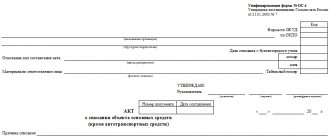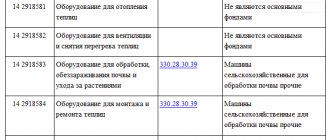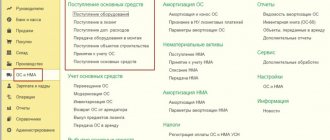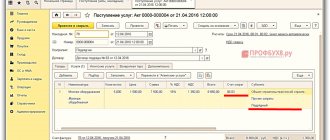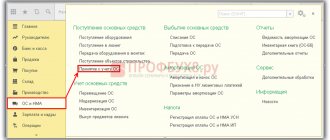Documentation of fixed asset accounting: receipt of fixed assets in the company
The rules for documenting the receipt of OS by an enterprise are not fixed in the Russian regulatory framework.
At the same time, certain provisions are contained in the law on accounting dated December 6, 2011 No. 402-FZ, as well as in the guidelines for fixed assets accounting, approved by order of the Ministry of Finance of the Russian Federation dated October 13, 2003 No. 91n. In particular, paragraph 38 of methodological instructions No. 91n explains that accounting should reflect the fact of receipt of fixed assets at the moment when the certificate of acceptance and transfer of fixed assets was signed by the head of the company.
IMPORTANT! It is indicated that such an act should be drawn up for each individual inventory item. An exception is provided only for fixed assets of the same type that have the same value, which the company takes into account at a time: in such a situation, it will be enough to draw up 1 general act for all such homogeneous fixed assets.
The legislator has not currently established any form of this act that would be mandatory for use by all companies. Since such a document is primary, the company can independently develop for its practice the form of such an act (by virtue of Article 9 of Law No. 402-FZ) or use the previously (before 01/01/2013) mandatory unified forms approved by the Decree of the State Statistics Committee of the Russian Federation dated 01/21/2003 No. 7.
This resolution contains the following forms of acts with which the company has the right to document the receipt of fixed assets:
- OS-1. This is a standard template that a company can use in relation to any newly received fixed asset with the exception of buildings (a special template is provided for them in the OS-1a form).
- OS-1b. A company can apply such a template if it takes into account not just one object, but a group of similar ones at once.
- OS-14. By an act in this form, the company can formalize the receipt at the disposal of the company (at its warehouse) of equipment that in the future (after installation) will be used as OS. The transfer of the OS for installation is formalized by an act in the OS-15 form.
IMPORTANT! Regardless of what act was used to document the receipt of the OS by the company, its acceptance into production for production should still be documented by an act according to the standard form OS-1.
After the receipt certificate has been drawn up, it, together with accompanying technical documents about the equipment, is transferred to the company’s accounting department. Accounting, in turn, opens an inventory card for each OS object (card form OS-6) or for a group of homogeneous OS objects (card form OS-6a). It is also possible to maintain an inventory book (form OS-6b).
For information about when the use of an inventory book is advisable, read the material “Unified Form No. OS-6b - Form and Sample.”
An order that will protect the transfer of fixed assets into goods and reduce property taxes
How the document will allow you to save money. Often a company is forced to pay property taxes on fixed assets that are not actually used and which it plans to sell. This is especially true in a financial crisis.
To avoid tax losses, some companies transfer such fixed assets to the “Goods” category. The logic is simple. Since the object is not capable of generating benefits in the future and is put up for sale, it does not meet the criteria of paragraph 4 of PBU 6/01 “Accounting for fixed assets” (approved by order of the Ministry of Finance of Russia dated March 30, 2001 No. 26n) and Article 256 of the Tax Code of the Russian Federation. Therefore, it should not be taken into account as part of the OS.
Let us remind you that according to paragraph 1 of Article 374 of the Tax Code of the Russian Federation, property tax is calculated according to accounting data.
Another reason to transfer is that if the asset is not used, tax authorities may not recognize the expenses associated with it in tax accounting. This also applies to depreciation charges. After all, it turns out that such expenses were not incurred to carry out activities aimed at generating income (clause 1 of Article 252 of the Tax Code of the Russian Federation). Of course, if the company is profitable, then you can do without the transfer and defend the costs. But if the organization reflects losses, then such a procedure will not lead to tax losses.
Another option, although not very profitable, is that the main product can be put into storage for a period of more than three months. But in this case, the company loses depreciation expenses (clause 3 of Article 256 of the Tax Code of the Russian Federation) and at the same time is forced to continue paying property tax (clause 63 of the Guidelines for accounting of fixed assets, approved by order of the Ministry of Finance of Russia dated October 13, 2003 No. 91n, Clause 3 of Article 256 and Clause 1 of Article 374 of the Tax Code of the Russian Federation). A similar opinion was expressed in the letter of the Ministry of Finance of Russia dated May 15, 2006 No. 03-06-01-04/101. Therefore, converting an asset into goods is more profitable than conservation.
It should be noted that when converting fixed assets into goods, the risk of claims is almost guaranteed. The fact is that such operations are not provided for in accounting. According to the Russian Ministry of Finance, an object is classified initially at the time of its recognition in accounting, and its transfer from one category to another is impossible (letter dated December 19, 2006 No. 07-05-06/302). Allegedly, such objects can only be written off from accounting accounts upon their sale, liquidation or other disposal.
But still, there are examples in practice when an organization has successfully used this method. For example, in resolution dated January 27, 2009 No. A65-9168/2008, the Federal Arbitration Court of the Volga District found that the transfer was justified. The reason is that fixed assets were not used due to the lack of scope of work and the need to use them in the future. One of the documents confirming the legality of transferring assets to the category of goods was an order from the manager. Similar conclusions are contained in the decision of the Federal Arbitration Court of the Central District dated July 4, 2008 No. A48-3994/07-14.
In what form is it compiled?
In the form of an order from the head of the company. After all, only he can recognize the lack of ability to bring benefits in the future - perhaps on the basis of the conclusion of a commission appointed by him. It is necessary that from the text of the order it is possible to draw an unambiguous conclusion about the necessity and advisability of such a translation.
What must be in the document.
First, it must be stated that the property is not used in the ongoing business. The reason could be, for example, a decline in production, lack of orders or re-profiling of activities.
Next, it is necessary to note why it is not profitable for the company to continue using the facility. Here you can refer, in particular, to the conclusion of internal specialists about the ineffective use of assets, to the decision of the general meeting of participants to change the main areas of activity. Similar documents can be attached to the order.
It would not be out of place to order the creation of a commission to determine the feasibility of further use of the fixed asset. The chief accountant must participate in it, as well as persons who are responsible for the safety of fixed assets (clause 77 of the Guidelines for accounting for fixed assets). The formation of a commission may be provided for in the same order to change the purpose of the object.
It is important to indicate in the order that the property being transferred to the category of goods is put up for sale. In this case, you can order the placement of advertising, for example, on the Internet.
Additional security measures.
The possibility of such a transfer can be specified in the organization’s accounting policies. In this case, it would not be superfluous to refer to paragraph 29 of PBU 6/01 “Accounting for fixed assets”, according to which the list of cases of disposal of fixed assets is open, and to paragraph 7 of PBU 1/2008 “Accounting policies of the organization”, indicating the right to supplement the list of accounting records. operations independently.
Note that when converting an asset into goods, you should be guided by PBU 6/01, since it has priority over the Methodological Guidelines for Accounting for Fixed Assets, which recommend writing off an object only when all conditions for recognizing an object as a fixed asset, and not just one, have ceased to apply. .
Example of an order to transfer fixed assets into goods
The procedure for registering the disposal of fixed assets in a company
The most common situations of disposal of fixed assets from production activity are associated with one of the following circumstances:
- the company decided to sell the OS;
- The enterprise's fixed assets are recognized as subject to write-off.
Each of the above circumstances requires specific documentation.
If a company sells its OS, then, as in the case of a purchase, it is necessary to draw up an acceptance certificate for the OS (clause 81 of guidelines No. 91n). It is drawn up according to the rules and forms described above in relation to the situation with the receipt of OS by the company. That is, if a company sells an asset that is not a building, then the act can be drawn up in the OS-1 form. If the building is being sold, then the most suitable template for the act is OS-1a. And in the case when a company simultaneously sells a group of homogeneous fixed assets, the disposal should be formalized by act OS-1b.
NOTE! The above acts should be drawn up not only in a situation where the OS is directly sold, but also when an object is transferred by a company to the authorized capital of another organization, as well as when transferred free of charge to a third party.
Such documents must be completed in any case, regardless of who the buyer is (an individual or a company). This was indicated by the Department of Tax Administration of the Russian Federation for Moscow in a letter dated May 17, 2004 No. 26-12/33266.
The second possible option is that the company’s OS is outdated, has completely served the allotted time period, or has broken down as a result of the influence of some external factors, while restoring or repairing such an OS is not economically feasible for the company. Such an OS should be decommissioned.
But for this, paragraph 77 of methodological instructions No. 91n requires the creation of a special commission of production experts who will decide whether such an OS should be written off or not.
If such a commission decides not to restore an asset, but to write it off completely, then after receiving a written decision of the commission, the company will have to document the fact of disposal of the asset with a special act. Its form, as well as according to the previously described documents, can be developed by the company independently or selected from standardized ones. In the latter case, these will be the following forms:
- OS-4 - if the company writes off one asset that is not a motor vehicle (for motor transport, form OS-4a should be used);
- OS-4b - when not one fixed asset is written off, but a group of similar ones.
After the act of disposal of the fixed assets is drawn up, the accounting specialist puts a mark on the inventory card of the object that the fixed assets have been disposed of.
Find out how to account for the sale of a fixed asset in the Typical Situation from ConsultantPlus. Study the material by getting trial access to the K+ system for free.
For information about what entries are made when disposing of fixed assets and how to calculate the retirement ratio, read the article . ”
Transfer for sale to another type of asset: possible or not
From 2021
With the reporting for 2021, the updated provisions of PBU 16/02 came into force, by virtue of which fixed assets scheduled for sale can be transferred to another asset class: long-term assets for sale (LTAs).
Assets are accepted for accounting as DAP at the moment when (simultaneously):
- Their use has been discontinued due to the decision to sell.
Important! Temporarily unused non-current assets are not transferred to DAP (clause 10.1 of PBU 16/02).
- It has been confirmed that the resumption of use of these facilities is not expected.
Confirmation can be:
- the corresponding decision made by the management of the organization;
- commencement of actions to prepare the asset for sale;
- conclusion of a sales agreement, etc.
With the transfer to DAP, fixed assets cease to be subject to property tax. An exception is real estate registered as a DAP, taxed at cadastral value (see letter of the Ministry of Finance dated January 22, 2020 No. 03-05-05-01/3316).
ConsultantPlus warns Please note: reclassification of fixed assets into DAP does not mean their transfer to the category of goods. Unlike goods, the financial result from the sale of DAP forms profit (loss) from other operations, and not profit (loss) from ordinary activities (Information message of the Ministry of Finance of Russia dated 07/09/2019 N IS-accounting-19). The transfer of fixed assets into goods, in our opinion, is still possible in rare cases, although this is not directly provided for by PBU 16/02... Read more about the requalification of fixed assets into DAP or into goods in K+. Trial access is available for free.
Until 2021
Previously, government financial authorities took an unambiguous position on the issue of transferring fixed assets into goods for sale - it is impossible. This opinion was based on the fact that PBU 6/01 does not provide for the transfer of fixed assets into goods, and writing off fixed assets from accounting is possible only upon their disposal.
Therefore, from the point of view of the regulatory authorities, an object that was initially acquired as a fixed asset should have remained in this status until the moment of sale (or disposal for other reasons). And from this it followed that property tax must be paid on this object until the moment of its sale (disposal). This opinion was reflected, in particular, in the letter of the Ministry of Finance dated March 2, 2010 No. 03-05-05-01/04.
But despite the principled position of tax authorities on this issue, organizations still tried to optimize property taxes in this way. Taxpayers tried to convert fixed assets into goods and tried to defend their position in court. They succeeded in this with varying degrees of success. A selection of judicial practice can be found in K+ by getting free trial access to the system.
How to reflect the reclassification of fixed assets into long-term assets for sale in accounting and what entries to make is explained in detail in the Ready-made solution from ConsultantPlus. If you do not already have access to this legal system, trial access is available for free.
What are the most common errors in documenting OS movement?
In practice, there are situations when a company forgets to formalize the acceptance of OS with the appropriate act, citing the fact that the legislator has not established a mandatory form for the application of such an act.
This approach is incorrect, since since January 1, 2013, companies have been given the right to develop their own forms of accounting documents, including the form of the certificate of acceptance and transfer of fixed assets. There is no single mandatory form. But this does not mean that the act can not be drawn up. After all, if there is no act, this means that the company actually admits that the OS object is not yet ready for use.
IMPORTANT! Only after signing the acceptance and transfer certificate can the company open an inventory card for the OS object.
At the same time, in practice, some organizations violate the procedure for documenting fixed assets by first opening inventory cards (at the time the assets arrive at the company), and then only signing the act (when the OS is ready for use).
An inventory card is a document that acts as a biography for an OS object. The company maintains such a card throughout the entire service life of the OS. A new card can only be created when the object has undergone a radical modernization, as a result of which the company can no longer record all the characteristics of the OS in the old card.
Therefore, if a company reissues cards for some objects with some frequency, then these actions should also be considered erroneous.
Results
The procedure for documenting the receipt of fixed assets into the company and the disposal of fixed assets from the company is in many ways similar: the corresponding act is signed, after which an inventory card is created or the necessary marks are put on such a card.
It is important for companies to understand: despite the fact that unified forms of acts have not been established today, the very need to prepare such documents remains. You can find more complete information on the topic in ConsultantPlus. Free trial access to the system for 2 days.


